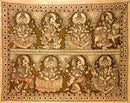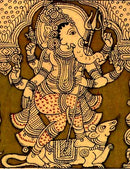The eight forms of Lord Ganesha have been vividly portrayed by the Kalamkari artist in a most beautiful manner. Kalamkari is a very popular art form from Andha Pradesh. The enhancing effulgence of colours and the characters that emerge on cotton fabric, help create a resplendent spread in this form of painting. Kalamkari art is unique in its use of colour as a medium to portray various Hindu mythological characters. The Mudgala Purana, an ancient text on Lord Ganesha, cites eight forms of Ganesha, prevailing over eight human weaknesses or demons. Ekadanta is the Conquerer of Moda, arrogance. Dhumravarna (smoke colored) overcomes Abhimana, pride; Vakratunda (curved trunk) is the Vanquisher of Matsarya, jealousy; Mahodara (big belly) is Lord of Moha, infatuation; Gajanana (elephant face) conquers Lobha, greed; Lambodara (corpulent belly) overcomes Krodha, anger; Vikata (deformed) conquers Kama, lust; Vighnaraja (King of Obstacles) prevails over Mamata (egotism). Thus Ganesha is "there" for even the lowest of the low, that there is hope for everyone, and that there really is "no intrinsic evil," only a seeming variation of the past containing all that has to be learned to live and grow from a young soul to an older one and then mature into rishi consciousness. He is "there for us." The Kalamkari art of painting undergoes a laborious, slow process of resist - dyeing and hand printing. Many stages have to be undergone before the final results are achieved. Unlike other styles of painting, Kalamkari painting demands a lot of treatment before and after the painting is completed on the cotton fabric. Depending on the treatment of cloth, or quality of the mordant, the colours change accordingly. Every step from soaking of the cloth, to sketching the outlines to washing and drying the cloth, is done carefully and correctly. The use natural dyes, extracted from bark, flower and root. Thus the colour red is obtained by using the Indian madder root, yellow from the pomegranate seed or even mango bark, and black from myrobalam fruit. No chemical dyes are used is producing Kalamkari colours! From whitening the cloth in a particular solution to the final painting, it is a labourious process and the artist has to put up lot of effort.
Description
The eight forms of Lord Ganesha have been vividly portrayed by the Kalamkari artist in a most beautiful manner. Kalamkari is a very popular art form from Andha Pradesh. The enhancing effulgence of colours and the characters that emerge on cotton fabric, help create a resplendent spread in this form of painting. Kalamkari art is unique in its use of colour as a medium to portray various Hindu mythological characters. The Mudgala Purana, an ancient text on Lord Ganesha, cites eight forms of Ganesha, prevailing over eight human weaknesses or demons. Ekadanta is the Conquerer of Moda, arrogance. Dhumravarna (smoke colored) overcomes Abhimana, pride; Vakratunda (curved trunk) is the Vanquisher of Matsarya, jealousy; Mahodara (big belly) is Lord of Moha, infatuation; Gajanana (elephant face) conquers Lobha, greed; Lambodara (corpulent belly) overcomes Krodha, anger; Vikata (deformed) conquers Kama, lust; Vighnaraja (King of Obstacles) prevails over Mamata (egotism). Thus Ganesha is "there" for even the lowest of the low, that there is hope for everyone, and that there really is "no intrinsic evil," only a seeming variation of the past containing all that has to be learned to live and grow from a young soul to an older one and then mature into rishi consciousness. He is "there for us." The Kalamkari art of painting undergoes a laborious, slow process of resist - dyeing and hand printing. Many stages have to be undergone before the final results are achieved. Unlike other styles of painting, Kalamkari painting demands a lot of treatment before and after the painting is completed on the cotton fabric. Depending on the treatment of cloth, or quality of the mordant, the colours change accordingly. Every step from soaking of the cloth, to sketching the outlines to washing and drying the cloth, is done carefully and correctly. The use natural dyes, extracted from bark, flower and root. Thus the colour red is obtained by using the Indian madder root, yellow from the pomegranate seed or even mango bark, and black from myrobalam fruit. No chemical dyes are used is producing Kalamkari colours! From whitening the cloth in a particular solution to the final painting, it is a labourious process and the artist has to put up lot of effort.
Payment & Security
Your payment information is processed securely. We do not store credit card details nor have access to your credit card information.




